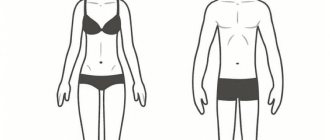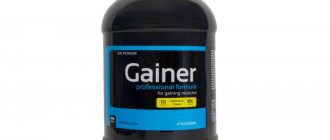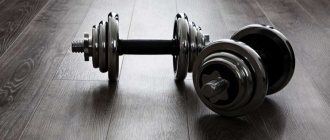If your goal is developed and voluminous muscles, then you should start with mass training. Learn how to create a muscle building program!
Why do you need a weight training program at all? Can’t you start drying right away? But you can’t! To show off voluminous and defined muscles, you first need to pump them up. In this article we will tell you what your basic mass training program should be and what rules you should follow to gain quality muscles.
Any training program for muscle mass must include a clear exercise schedule, a balanced diet, the best foods for mass, and sufficient recovery time. Moreover, this set of recommendations is radically different from the so-called drying - the period of working out the relief.
It is important here not to confuse the types of training, because the price of a mistake is quite high: you can lose the muscles you gained so hard and waste a lot of time and money. To prevent this from happening, it is enough to remember the basic principles of weight gain.
According to the structure of the content. For each training day, a video of the following format has been prepared, as well as a training module with a complete list of exercises with video instructions for the technique.
All you have to do is try out all the suggested tips in the gym on yourself and set a goal.
Principles of a muscle mass training program
Gaining muscle mass is the main goal of men who come to the gym. Its achievement depends on many factors.
How much to train
The duration of one lesson in the gym should not exceed 1 hour. If you exercise longer, you will become overtired and begin to burn muscles. The break between sets should last 1-4 minutes, this is enough to recover. An excessively long rest period can reduce the effectiveness of the exercise - the muscles will return to their original state, which was before the start of the workout.
How often to train to gain mass?
There are also certain requirements for the rest period between workouts for certain muscle groups - at least 72 hours. Hence the recommended frequency of training - no more than four per week: 3 strength and 1 light recovery.
Every workout involves breakdown of muscle fibers, depletion of key nutrients, and, of course, fatigue. This leads to a decrease in functionality. From this starting point, your body will recover by increasing muscle protein synthesis to rebuild muscle tissue, bringing you back to baseline as quickly as possible. If recovery is normal, a period of supercompensation occurs, during which your functionality exceeds your baseline level. This means that your muscles are growing faster than before.
Thus, for one muscle group you do the following training from the third to the eighth day. Exercising more frequently will put your body into overtraining mode.
The base is the head of everything
Just as a reliable house is impossible without a foundation, so perfect relief is unattainable without a strong muscular frame. Do you want to become huge? Do a basic weight training program! It is on this basis that you will build voluminous muscles in order to subsequently sharpen their relief in training.
“Basic” are multi-component exercises that train several muscle groups at once, while isolating exercises work only on one. Start the first stage of training (1-3 weeks) with basic exercises - deadlifts, squats and bench press, and then move on to building individual muscle groups in the second stage (4-6 weeks) using a split program according to:
- increasing the volume of the biceps,
- pumping the legs,
- building shoulder muscles
- back pumping.
At the third stage of gaining muscle mass (7-9 weeks), you can additionally begin detailed work on the trapezius, triceps, forearms and other smaller muscles. Now let's look at the second training session of the base period.
Reps and sets for bulking
The optimal range of repetitions of one exercise in a set is 6-12, in total there should be no more than three such approaches (or sets). Work in a relaxed manner, concentrating on correct technique. Why rush? Gaining mass requires a thoughtful and thorough approach, while neglecting technique leaves its mark on the speed of achieving results and its quality.
Moreover, not only beginners, but also some experienced bodybuilders are guilty of this. Be smarter and work exclusively for results.
Use free weights
An effective training program for gaining mass must certainly include work with free weights, because it is exercises with weights - with a barbell and dumbbells - that promote active muscle growth. Just don't let your muscles get used to a certain weight, otherwise they will stop growing. Increase your working weight, but remember: you need to do this gradually.
Let's look at the third training session of the base period.
Shock is our way
Every 3-4 weeks, make some changes to your program so that your muscles do not have time to adapt and become stressed from the unusual load. You can increase the intensity of your classes, add new exercises, increase the load, etc. Constantly expand your knowledge on methods of influencing the body and pumping muscles.
Recovery and muscle gain
This may surprise you, but muscle fiber growth occurs not during training, but during rest. This means that high-quality muscle hypertrophy can be achieved only by following a recovery regime. Proper muscle recovery after training is one of the keys to your success in your chosen goal. Consider massages and foam roller exercises for this.
Protect your muscles from overexertion and give them time to recover. The ideal option is to choose a program that uses one muscle group no more than once a week. This way you will gradually work your entire body without overloading.
The key to high-quality weight gain is a training program chosen wisely and taking into account the characteristics of your body.
Our recommended mass gain training program is suitable for intermediate to advanced bodybuilders. The training plan is designed for 6-8 weeks.
How to regulate the load?
The load must be increased with each workout in order for you to progress and move towards your desired goal. However, it is important to remember that at the initial stage you need to gradually become involved in the training process so that the body has time to adapt to the stress that you give it. Yes, training is dosed stress! And it is extremely important to dose it correctly! This is one of the most common mistakes of beginners - when they come to the gym for the first time, they train very intensely and overload their muscles so much that the next day they can barely move individual parts of the body due to muscle pain. Remember that pain is not an indicator of progress at all, but only evidence that you have given a load that exceeds what your body is accustomed to. This may sound strange, but progress can be made without so-called muscle soreness at all - muscle pain. Load yourself at the initial stage so that you rate the load at 5-7 out of 10 points on a scale of your own feelings. Increase it gradually, let your body recover and adapt to it.
If you are already a fairly experienced trainee, then you can use so-called split programs - training options when you work out different muscle groups on different days. Also, in addition to exercise machines, it is important to include in your training exercises with free weights - barbells and dumbbells. This way you will force the muscles to be more involved in the work, and, as a result, the training effect will be stronger. As for the intensity of the load, here you can work in the range of 8-10 points on the same scale that we talked about above.
Training program for gaining weight
DAY 1
DAY 2
DAY 3
DAY 1
DAY 1
DAY 2
DAY 3
Perform the last set of each exercise to failure. Variations of the exercises are possible - replacing the barbell with dumbbells.
Bench press with a wide grip lying on a horizontal bench
- 3 sets of 8-10 reps
- Body part: Chest Equipment: Barbell
Incline Dumbbell Press (30 degrees)
- 3 sets of 8-10 reps
- Body part: Chest Equipment: Dumbbells
Dumbbell flyes on a horizontal bench
- 3 sets of 10-12 reps
- Body part: Chest Equipment: Dumbbells
Bench press on a horizontal bench (close grip)
- 3 sets of 10-12 reps
- Body part: Chest Equipment: Barbell
Seated French press
- 3 sets of 10-12 reps
- Body part: Triceps Equipment: Dumbbells
Hanging Knee Raises
- 3 sets of 10-12 reps
- Body Part: Press Equipment: No
Pull-ups
- 3 sets of 8-12 reps
- Body Part: Lat Equipment: Bodyweight
Bent-over barbell row
- 3 sets of 8-10 reps
- Body Part: Press Equipment: Barbell
Reverse grip pull-ups
- 3 sets of 8-10 reps
- Body Part: Lat Equipment: Bodyweight
Deadlift
- 4 sets of 8-10 reps
- Body part: Quadriceps Equipment: Barbell
Barbell curl
- 3 sets of 10-12 reps
- Body part: Biceps Equipment: Barbell
Seated dumbbell curls
- 3 sets of 10-12 reps
- Body part: Biceps Equipment: Dumbbells
Hyperextension on a bench
- 4 sets of repeats until failure
- Body Part: Lower Back Equipment: Bodyweight
Treadmill workout
- 15 minutes
- Body part: Quadriceps Equipment: Exercise
Squats
- 4 sets of 8-12 reps
- Body part: Quadriceps Equipment: Barbell
Barbell squats with narrow feet
- 3 sets of 10-12 reps
- Body part: Quadriceps Equipment: Barbell
Seated calf raise with barbell
- 4 sets of 15-20 reps
- Body part: Calves Equipment: Barbell
Seated barbell press
- 3 sets of 10-12 reps
- Body part: Shoulders Equipment: Barbell
Two-hand dumbbell lateral raises
- 3 sets of 10-12 reps
- Body part: Shoulders Equipment: Dumbbells
Dumbbell lateral raises while standing (or sitting)
- 3 sets of 10-12 reps
- Body part: Shoulders Equipment: Dumbbells
General training rules
The volume of training must be such that the body is able to digest it, so the key factor in this case is the duration of the training. Training in the gym depends on its purpose, but it should not exceed 60 minutes. This refers to direct training with iron, not including warm-up. The bottom line is that within 60 minutes the hormonal levels sharply deteriorate, the level of testosterone and insulin drops, as a result of which catabolic processes begin to prevail over anabolic ones, and instead of progress, regression occurs. Of course, it is also important to take into account the intensity of the workout, which directly depends on which muscle fibers you are working. That is why, when an athlete trains for strength, he can pump longer than when working on weight, since in the first case glycolytic and high-threshold fast muscle fibers are trained, and in the second, oxidative ones.
The time under load and the rest time between approaches depend on the goal, strength or mass. If, in order to properly swing for strength, it is necessary to load the muscles in each approach for 10-20 seconds, which is approximately equal to 3-6 repetitions, then when training for weight, the athlete performs 6-12 repetitions, as a result of which the muscles are under load for 20- 50 seconds. But the rest time between approaches during strength training, on the contrary, is longer; the athlete can rest for 5 or 10 minutes, and while gaining weight, the rest lasts up to 1 minute between approaches. What is typical is that during relief training, the rest between approaches is even shorter, and there are even more repetitions, while such training is the shortest. It is not difficult to conclude that as intensity increases, the duration of the workout decreases.
Progression of loads is an inviolable rule of training, which consists of constantly trying to give your muscles more load. Such progress is most easily accomplished by increasing the working weights on the bar. This doesn't mean that you need to grow in every set of every exercise from workout to workout, no, that's not how it works. It is enough for you to perform at least one approach with a large weight in the basic exercise for the muscle group being trained. Let's say you are trying to pump up your chest , which means that the basic exercise is the bench press or angled press, and these are the ones you should try to progress in the first place. At the same time, in other exercises it is also necessary to try to increase the weight, but again not necessarily in all approaches.
But even if you lift absolutely correctly, it will most likely become problematic to progress very soon using weights. Actually, even when this is possible, it will still rarely be possible to increase the weight and keep the number of repetitions at the same level. More often than not, you will increase the weight and the number of repetitions will drop. Therefore, the progression of loads will occur in cycles. In the first cycle you will increase the weight, accordingly, the repetitions will fall, and in the second cycle you will try to perform the same number of repetitions with more weight. This progression scheme is the simplest and most effective, but over time its effectiveness begins to decline and then more progressive training methods . They are no better, it’s just that when the muscles are already accustomed to a certain stress, then in order to “surprise” them, to give them an incentive to adapt, an unusual load is needed. The bottom line is that the growth of muscle mass is only an external reflection of the body’s adaptation to the load it receives during training.
Systematicity is another rule of training that should always be followed, regardless of training level or training stage. First of all, you need a training diary , which will help you adhere to the principle of constant progression of loads. Without a diary, you will not be able to track your progress or make adjustments to your training program, since your training simply will not be a system. A lot of guys work out without a diary, and they have no results for years, so be sure to start a diary, record everything in it and try to beat your previous “records” every training session. At the same time, it is not enough to just swing correctly; it is also important to recover correctly. We will look at what exactly should be done for correct recovery later, since it depends on the specific training cycle, but for now it is important to note that recovery should lead to supercompensation .
Conclusion: training rules must be followed to ensure that the body receives adequate load during training, so that the athlete can avoid overtraining. At the same time, you should definitely try to progress the load, since this is the only way to force the body to adapt, and the adaptation of the body will externally look like an increase in muscle mass. In order for progress to become possible, it is necessary to keep a training diary and monitor recovery, since progress is only possible in one case if the muscles reach the point of supercompensation during their next workout.
How to start swinging correctly
A novice athlete, first of all, needs to correctly set a goal, since at the initial stage there is no need to strive to gain muscle mass or increase strength indicators, this will have to be done in the future. The main task of a novice athlete is to prepare all body systems for future training in the gym. First of all, it is necessary to develop muscle feeling , that is, to work out the technique and learn how to properly contract muscle fibers. The best way to achieve your goal is circuit training, which uses light working weights, about 50%, and such training should consist of basic exercises. The beginner training program is perfect for solving these problems. This training period lasts from 2 to 4 months, depending on the physical fitness of the athlete.
We have already written in detail about recommendations for beginners in the article about bodybuilding for beginners , but here we will briefly note the basic rules: during training, the athlete should not reach positive failure, for this purpose only 50% of the working weight is used; workouts should be short and last no more than 40 minutes; training should be circular, and the technique of performing exercises should be ideal. The preparatory stage of training is the most important, so we strongly recommend not to rush, in 2 months you still will not gain muscle mass, no matter how correctly you pump, especially since without proper preparation your body simply will not digest such a load, which theoretically can stimulate hypertrophy muscles. Be patient and spend at least 2 months preparing. Believe me, it will pay off triple and in the very near future!
Proper nutrition for gaining muscle mass
There is one more important rule of the mass training program. It sounds a little bloodthirsty, but in the world of bodybuilding, your success in gaining mass depends on what and how you eat. Your muscles will be built from the material with which you will nourish your body. If you start feeding proper and healthy food, you will get a beautiful and healthy body with developed muscles.
If you indulge in unhealthy foods, be prepared to gain fat instead of weight. Stop feeding altogether and forget about the perfect and proportional body of a bodybuilder.
Muscles are forged not in the gym, but in the kitchen!
Growing muscles constantly require building material, and to keep your house strong and beautiful, your diet must contain a balanced ratio of proteins, fats and carbohydrates, and be rich in vitamins, minerals and fiber. But since we are interested in gaining high-quality muscle mass, we put high protein content at the forefront.
He is the one who can turn you into a huge and pumped up guy. Chicken breast, turkey, cottage cheese, fish, legumes and nuts - this is an incomplete list of dishes that you should love with all your heart while sitting on the mass. You will find a wide list of available products that promote muscle growth in muscle building nutrition, which will help you plan your diet correctly.
We suggest you take the following sample menu for one day as a basis and create an ideal diet for yourself.
How I gained “lean muscle mass”
As I already said, what pushed me to go to the gym was that I began to gain weight. That is why, when I began to work on myself, I was pathologically afraid of returning to that same state. I was afraid of turning back into the fat, doughy guy I used to be.
I wanted to gain muscle mass, but not gain excess fat. I was afraid of this.
That is why I had to study this issue very deeply.
Is it possible to gain muscle mass without fat or with a maximum bias towards muscles?
We have already talked to you about the fact that simultaneous burning of fat and gaining muscle mass is a very difficult task, if at all possible, because, with a lack of calories, the body triggers catabolic (destructive) reactions that affect the muscles too.
Therefore, gaining muscle becomes almost impossible when you are in a calorie deficit. But, nevertheless, there are certain tricks that allow you to gain muscle mass with a minimum content of fat in the body.
Today the topic will be very interesting and unexpected. Lean muscle mass is a very convenient myth for sports nutrition manufacturers and fitness centers. But we will actually look at some points that allow you to gain muscle while dieting.
Meal 1
French toast
- 2 pcs.
- 128.4 Kcal
- 4.5 proteins, g
- 3.7 fat, g
- 19.2 carbohydrates, g
Omelette
- 1 whole egg, 10 egg whites and spices to taste
- 235.5 Kcal
- 16.1 proteins, g
- 18 fats, gr
- 1.1 carbohydrates, g
Meal 1
- 363.9 Kcal
- 20.6 proteins, g
- 21.7 fat, g
- 20.3 carbohydrates, g








